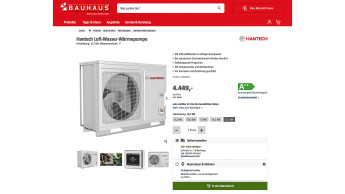The company has expanded almost twenty times over since then and is only just short of having a presence throughout the entire country. This is why Home Depot can regard itself as the market leader in home improvement, especially since the small specialist dealers tend to regard the big enterprise as the "all-in-one supplier".
Home Depot based its strategy on the acquisition of existing key shops, which helped the company to position itself and which are now of service in carrying out its plans. The company began by purchasing the Total Home chain from Grupo Alfo, which was regarded as the country's second-biggest home improvement firm with three stores in Monterrey and one in the capital. In 2002 Home Depot took over the Del Norte chain of shops, which had been in existence since 1949. Two years later it swallowed 20 stores belonging to the Mexican Home Mart chain - a key acquisition that allowed the company to develop into the biggest home improvement retail chain in Mexico with more than 70 outlets.
Before Home Depot made its appearance in the country, do-it-yourself was up to a point unfamiliar to the Mexican consumer, who had nevertheless for years been regularly carrying out repairs in the private sphere (as much from habit and upbringing as from economy). Now the home improvement retailer offers more than 30 million customers a year 20 000 different items, more than 80 per cent of which are manufactured in Mexico.
And whereas the company is cutting back the rate of openings in the United States and threatening redundancies, its Mexican subsidiary hopes to maintain its growth and improve its range of services. Although Home Depot announced sales to the tune of US $ 14.6 bn in the fourth quarter of 2009, that is still a 0.3 per cent decline compared with the same period one year previously. Even though that was very little, Home Depot still announced 1 000 job cuts and the closing of three stores in the United States at the beginning of this year.
It was against this background that Lowe's, the second-biggest DIY chain in the USA, announced the opening of two stores in Monterrey, Nuevo León, in February and also gave notice of its intention to construct three more outlets in the not too distant future. This means the company has started up its activities in Mexico by investing the sum of US $ 100 mio.
At the end of 2009 the company assumed that the industry had suffered a serious sales slump in the United States. Consequently it decided to put the brakes on its expansion in the US home market and look for new horizons. In Australia it has got together with the Woolworth chain, and it has also decided to invest in Mexico, which represents a vote of confidence in the Mexican market.
Although Lowe's rates investment on Mexican soil as attractive, the company had to take on its arch rival Home Depot and, apart from that, exist within the competition in an extremely fragmented market that comprises thousands of small businesses which make up nearly 90 per cent of that market.
For their part, resourceful engineers from the engineering faculty of the University of Mexico have now entered the DIY market with the publication at the beginning of the year of a technique that enables you to build your own home without cement and on practically any terrain. The project, which is called Habtec, is being presented as the ideal solution for the country's lack of housing (the total number of residential buildings is just under six million).
This novel building is erected with a thousand structural elements of a light, durable material that are held in place by tubes positioned vertically on the foundation. They are assembled without the need for cement or any other adhesive. The heaviest sections, which form the ceiling, weigh no more than 35 kg, so that two people can fit them together without any trouble. Once the sections are assembled they are kept in position by their own weight, which provides stability for the walls. The developers of the project affirm that such a building, even though small (50 m² with the possibility of extending), will withstand a hurricane.
And so do-it-yourself is gradually gaining in significance in Mexico, although it has not developed in the same way as in other countries. It is absolutely certain that, if the crisis goes on and results in a shortage of tradesmen, this sector will see consolidation within a short space of time.

 Menü
Menü
















